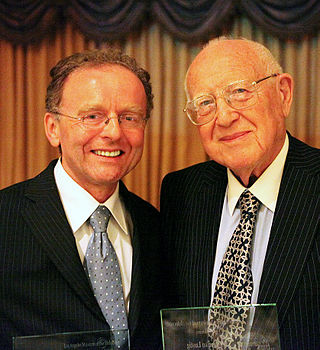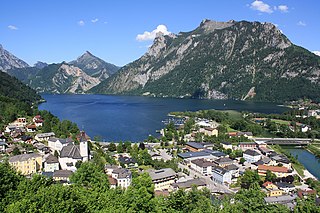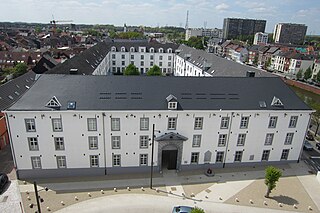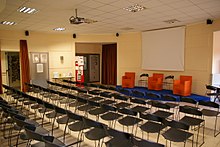
The Romani Holocaust or the Romani genocide was the planned effort by Nazi Germany and its World War II allies and collaborators to commit ethnic cleansing and eventually genocide against European Roma and Sinti peoples during the Holocaust era.

Mauthausen was a concentration camp that first appeared in 1918, and the original Mauthausen camp was not situated precisely on the same spot as the latter more commonly known Mauthausen opened 20 years later. The latter Mauthausen was situated on a hill above the market town of Mauthausen, Upper Austria. It was the main camp of a group with nearly 100 further subcamps located throughout Austria and southern Germany. The three Gusen concentration camps in and around the village of St Georgen/Gusen, just a few kilometres from Mauthausen, held a significant proportion of prisoners within the camp complex, at times exceeding the number of prisoners at the Mauthausen main camp.

Gedenkdienst is the concept of facing and taking responsibility for the darkest chapters of one's own country's history while ideally being financially supported by one's own country's government to do so. Founded in Austria in 1992 by Andreas Maislinger, the Gedenkdienst is an alternative to Austria's compulsory national military service as well as a volunteering platform for Austrians to work in Holocaust and Jewish culture-related institutions around the world with governmental financial support. In Austria it is also referred to as Austrian Holocaust Memorial Service provided by the Austrian Service Abroad. The Austrian Gedenkdienst serves the remembrance of the crimes of Nazism, commemorates its victims and supports Jewish cultural future. The program is rooted in the acknowledgment of responsibility by the Austrian government for the crimes committed by National Socialism.

The Austrian Service Abroad is a non-profit organization which sends young Austrians to work in partner institutions worldwide serving Holocaust commemoration in form of the Gedenkdienst, supporting vulnerable social groups and sustainability initiatives in form of the Austrian Social Service and realizing projects of peace within the framework of the Austrian Peace Service. Its services aim at the permanence of life on earth. The Austrian Service Abroad carries and promotes the idea of the House of Responsibility for the birthplace of Adolf Hitler in Braunau am Inn. The Austrian Service Abroad is the issuer of the annually conferred Austrian Holocaust Memorial Award. The program is funded by the Austrian government.

Prato is a city and comune in Tuscany, Italy, and is the capital of the Province of Prato. The city lies northeast of Tuscany, at an elevation of 65 metres (213 ft), at the foot of Monte Retaia. With 195,213 inhabitants as of 1 January 2023, Prato is Tuscany's second largest city and the third largest in Central Italy.

Ebensee am Traunsee is a market town in the Traunviertel region of the Austrian state of Upper Austria, located within the Salzkammergut Mountains at the southern end of the Traunsee. The regional capital Linz lies approximately 90 km (56 mi) to the north, nearest towns are Gmunden and Bad Ischl. The municipality also comprises the Katastralgemeinden of Langwies, Oberlangbath, Rindbach, Kohlstatt and Roith.

The Mémorial des Martyrs de la Déportation is a memorial to the 200,000 people who were deported from Vichy France to the Nazi concentration camps during World War II. It is located in Paris, France, on the site of a former morgue, underground behind Notre Dame on Île de la Cité. It was designed by French modernist architect Georges-Henri Pingusson and was inaugurated by Charles de Gaulle in 1962.

The Mechelen transit camp, officially SS-Sammellager Mecheln in German, also known as the Dossin barracks, was a detention and deportation camp established in a former army barracks at Mechelen in German-occupied Belgium. It served as a point to gather Belgian Jews and Romani ahead of their deportation to concentration and extermination camps in Eastern Europe during the Holocaust.
Kazimierz Smoleń was a Polish political prisoner of the Nazi World War II KZ Auschwitz, and later a long-term director of Auschwitz-Birkenau State Museum.
The Fossoli camp was a concentration camp in Italy, established during World War II and located in the village Fossoli, Carpi, Emilia-Romagna. It began as a prisoner of war camp in 1942, later being a Jewish concentration camp, then a police and transit camp, a labour collection centre for Germany and, finally, a refugee camp, before closing in 1970.

Beaune-la-Rolande internment camp was an internment and transit camp for foreign-born Jews, located in Beaune-la-Rolande in occupied France, it was operational between May 1941 and July 1943, during World War II.

Hans Maršálek was an Austrian typesetter, political activist, detective, and historian. A devout socialist and active in the resistance, he was arrested by the Nazis and imprisoned in the Mauthausen concentration camp. After the war, he joined the Austrian political police and was instrumental in tracking down and convicting numerous Nazi criminals. He also became the main chronicler of the camp's history, helped establish the Mauthausen Memorial Museum, and published several books.

Moshe Ha-Elion, also written Moshe Haelion, Moshe 'Ha-Elion, Moshé Ha-Elion, Moshé 'Ha-Elion, Moshé Haelyon, was a Holocaust survivor and writer. He survived Auschwitz, the death march, Mauthausen, Melk, and Ebensee. He is the author of a memoir, מיצרי שאול, originally written in Hebrew and translated into English as The Straits of Hell: The chronicle of a Salonikan Jew in the Nazi extermination camps Auschwitz, Mauthausen, Melk, Ebensee. He wrote three poems in Ladino based on his experience in the concentration camps and the death march: "La djovenika al lager", "Komo komian el pan", and "En marcha de la muerte", published in Ladino and Hebrew under the title En los Kampos de la Muerte. Moshe Ha-Elion translated Homer's Odyssey into Ladino. He lived in Israel. He had two children, six grandchildren, and nine great-grandchildren.

The Memoriale della Shoah is a Holocaust memorial at the Milano Centrale railway station commemorating the Jewish prisoners deported from there during the Holocaust in Italy. Jewish prisoners from the San Vittore Prison, Milan, were taken from there to a secret underground platform, Platform 21, to be loaded on freight cars and taken on Holocaust trains to extermination camps, either directly or via other transit camps. Twenty trains and up to 1,200 Jewish prisoners left Milan in this fashion to be murdered, predominantly at Auschwitz.

Gusen was a subcamp of Mauthausen concentration camp operated by the SS between the villages of Sankt Georgen an der Gusen and Langestein in the Reichsgau Ostmark. Primarily populated by Polish prisoners, there were also large numbers of Spanish Republicans, Soviet citizens, and Italians. Initially, prisoners worked in nearby quarries, producing granite which was sold by the SS company DEST.

Nerina De Walderstein (1925–2011) was an Italian partisan, who survived the Auschwitz concentration camp. After the war, she continued to speak and teach publicly about the concentration camps and her experience. She was born and died in Trieste.



















